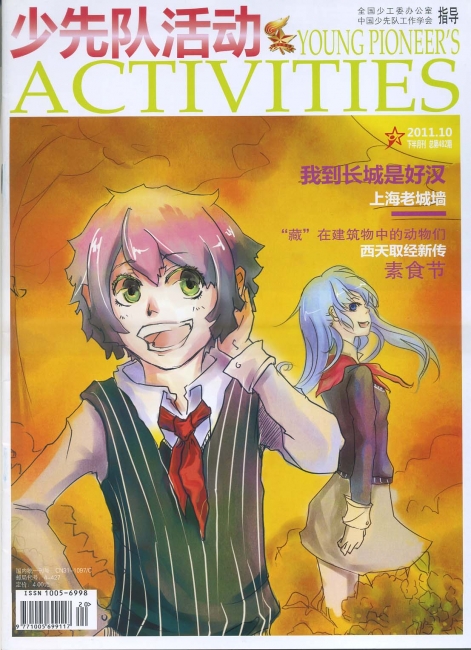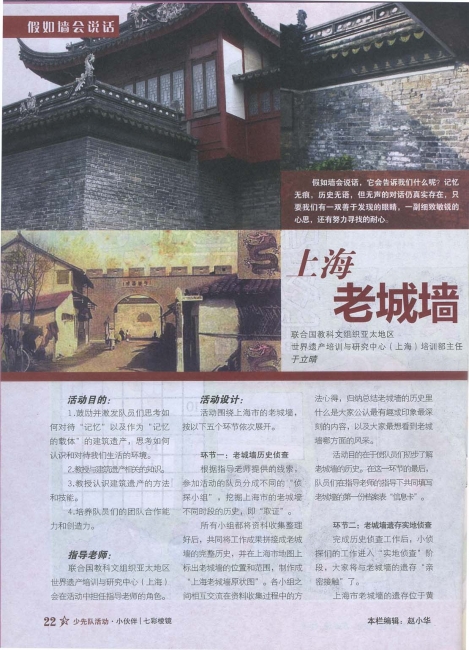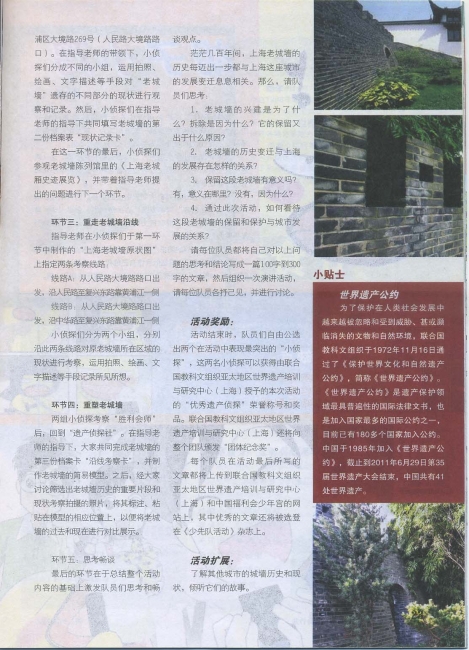| A New Specialty Column in Magazine Promotes the Study of Heritage to Teenagers |
| From:WHITRAP Shanghai Author:YU Liqing PublishDate:2011-10-25 Hits:12923 |
|
SECOND STAGE ACTIVITY Activity objectives: 1 Encourage participants to think about the meaning of "memory" and the role of architectural heritage as a “carrier of memory", as well as the environment we live in. 2 Teach the related knowledge of architectural Heritage. 3 Teach the methods and skills of recognizing architectural heritage. 4 Encourage cooperation and creativity among team members. Leadership: The UNESCO Asia-Pacific Heritage training and Research Center (Shanghai) will serve as leader for the activities. Activity Plan: The activity will focus on the old city wall in Shanghai and will be conducted according to the following five steps: Step 1: Investigating the past of the old city wall. Using clues provided by the teacher, the participants are divided into different "detective groups" and are to discover the history of the old city wall in different time periods. This activity will be referred to as "gathering evidence". In order to ensure the efficiency of this step, the detective groups can work in cooperation with a due division of labor according to clues provided. After all materials have been collected, a complete history of the old wall may emerge. The team members can mark the location and area of the old city wall and draw a special “old city wall map”. The two groups may share their experiences gained from the above steps with each other, summarize the funniest or most impressive parts among the long history of the old city wall and choose the part of the old city wall that most team members want to have a more in-depth look at. The purpose of this step is to allow team members to have an image of the history of the old city wall. At the end of this part, the team members will produce the first profile, called an ‘Information Card’ of the old city wall under the guidance of the teacher. Step 2: Field investigation of the old city wall After accomplishing the detective task, the “little detectives” move into the "on-site investigation" stage, having “intimate contact" with the old city wall. The old city wall of Shanghai is located on 269 Dajing Road in Huangpu District (at the intersection of Renming Road and Dajing road). Under the guidance of the teachers, the “little detectives” are divided into different groups and are to use photography, drawing, words or other means to observe and record the different parts of the remains of the old city wall. After that, the “little detectives” may file the second profile, the "status record card" of the old city wall. At the end of this stage, the “little detectives” will visit the “Old City (Lao Cheng Xiang) Heritage Exhibition" in the Shanghai Old City Wall Gallery and then enter into the next stage with the questions raised by the teacher. Step 3: Retracing the route of the old city wall The teacher will specify two inspection lines on the “original old city wall map” made by the “little detectives” in the first step. Line A: From the intersection of Ren Ming Road and Da Jing Road, along Ren Ming Road to East Fuxing Road by the Huangpu river side Line B: From the intersection of Renming Road and Dajing Road, along Zhonghua Road to East Fuxing Road by the Huangpu river side. The “Little detectives” may be divided into two groups to inspect the old city wall along the two lines respectively, and then use photography, drawing or words to describe what they have seen and their feelings about that. Step 4: Remodeling the old city wall As the two detective teams “join forces” with each other after investigation and return to the “heritage detective group”, they may complete the third profile card or “field investigation card” and make a simple model of the old city wall under the guidance of the teacher. After selecting the photos which represent the important historical past and present situation of the old city wall, team members should mark or paste them on the corresponding position of the model so that the contrast of the past and the present of the old city wall can be clearly displayed. Step 5: Think and Talk The final step is to summarize the whole activity and stimulate the team members to think and speak out their views. Each change that has happened to the old city wall is closely related to the development and changes of the city in the past hundred years, which brings about the following questions: 1 Why was the old city wall built and why it was removed? Why has it been preserved? 2 What is the relationship between the changes of the old city wall and the development of Shanghai? 2 Is it worthwhile to preserve the old city walls? Why and why not? 4 How should we view the relationship of the retention and protection of the old city wall and the development of the city through this activity? Each team member should write down their thinking and conclusions about the above questions in a 100 to 300 word essay, and then organize a speech to deliver their own thoughts. A group discussion might follow later. Activity award: At the end of the activity, team members may choose two most outstanding “little detectives”. The two detectives can obtain the honor and prize presented by the UNESCO Asia-Pacific Heritage training and Research Center (Shanghai). The Center will also provide the whole team a “Group Memorial award". The articles written by each team member will be uploaded to the website of UNESCO Asia-Pacific Heritage training and Research Center (Shanghai) and China Welfare juvenile Palace. Among those, the best essays will be published in the "Young Pioneers Activities" magazine. Post-activity tasks: Understand the history and current situation of other city walls and listen to their stories.
|
|
|
- Documentary: 2023 World Heritage Creative X Innovators Conference and the AWHEIC Third Anniversary Celebration
- Publication | WHITRAP Newsletter No. 61
- Mt. Huangshan first show in Climate Action for World Heritage
- Call for Good Practices: 2024 Environment and Resilience
- FAQs | 2024 Call for Good Practices
- Operational Guidelines for the Implementation of the World Heritage Convention 2017
Copyright © 2009-2012 World Heritage Institute of Training and Research-Asia and Pacific (shanghai)





